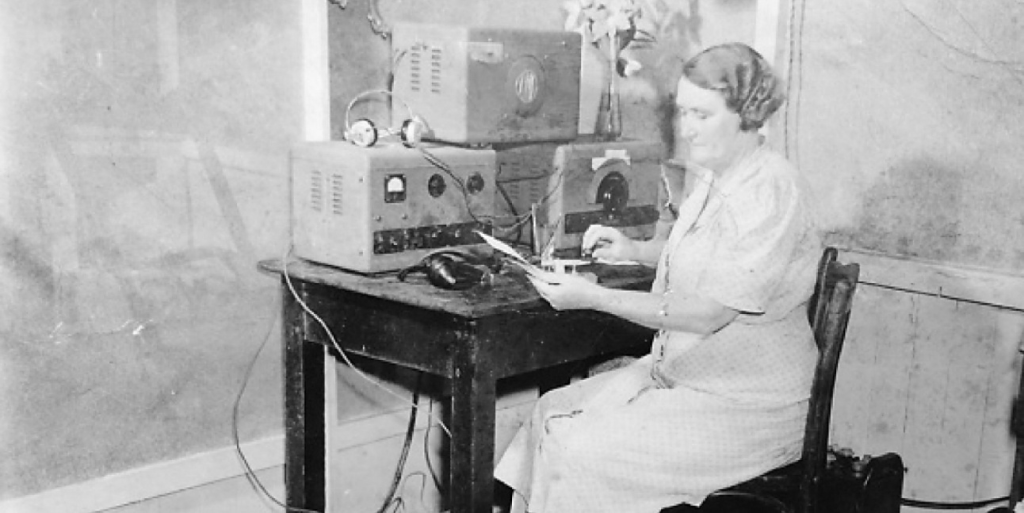Ruby Olive Boye, born in Sydney on 29 July in 1891 in Sydney, was the fifth of eight children. She worked in retail until her marriage on 25 October 1919 to Sydney Skov Boye. Ruby was described as a tall and imposing woman who radiated a natural dignity and a ‘dignified and imposing woman, with dark, wavy hair and a warm smile’. They had two sons and from 1928 to 1936 the family lived at Tulagi, British Solomon Island’s Protectorate before moving to Vanikoro Island in the Santa Cruz group so that Skov could manage the Vanikoro Kauri Timber Company. As the Japanese imposed their presence in the Pacific civilians were evacuated. The Vanikoro tele/radio operator returned to Australia to enlist. Before he left Ruby begged him to teach her to operate the radio and transmit voice reports. She taught herself Morse code and exchanged messages with residents on other islands.
I learnt how to read the panel of instruments for the weather reports, there were plenty of storms and hurricanes. Soon after, there was news of Pearl Harbour being bombed and we were a bit scared about that. I was sending messages to Tulagi where they were compiled, then Tulagi was bombed, so I was advised through coded messages to use Morse code, which I had practicing since a ‘Jap’ had called me and told me to get out or else.

Ruby Boye-Jones. (ADB)
As the Japanese pushed south Ruby refused to evacuate and began to send intelligence concerning Japanese movements to the Brisbane office of the ‘Coastwatchers’. Head of the Coastwatcher organisation, Commander Eric Feldt, had no hesitation in accepting her assistance and welcomed her into his select brave team. By May 1942 the Japanese occupied Tulagi and Guadalcanal and the invasion of the Santa Cruz Islands appeared imminent. Ruby and Skov chose to remain, and Ruby continued to provide valuable intelligence. Australian Officialdom finally conceded in July 1943 that Ruby should be given the RAN reserve rank accorded Coastwatchers. Being the only woman Coastwatcher, she was made an honorary WRANS Third Officer, and a uniform was parachuted into her, so that if captured she would be treated as a military Prisoner-of-War. Such a sensibility was unlikely to be observed by the Japanese, who aware of her presence, attacked Vanikoro with aircraft on a number of occasions.

Honorary 3rd Officer Ruby Boyd-Jones. (RAN)
Along with the uniform the RAN had decided to include in the air-drop cosmetics. Ruby was amused and transmitted the message; ‘Thanks for the goodies, I am now a raving beauty’.
The Japanese contacted Ruby directly informing her that she must cease transmitting or they would discover her whereabouts and execute her as a spy. ‘Calling Mrs Boye on Vanikoro. We are coming to get you Mrs Boye on Vanikoro. We are coming to get you Ruby’. At this point other Coastwatchers began to jam the airwaves, to blot out the rest of the message. They felt it was necessary to add some good Australian expletives as to what the Japanese operator could do.
Ruby admitted the situation was becoming precarious.
We would hear the throbs of submarines on the reef. We would see ‘Jap’ planes flying over. Later on, they bombed one of the aircraft tenders that were in the harbour.
She continued to relay messages on Japanese ship movements as well as weather forecasts vital for Allied supply drops and air raids and Allied fleet activities. The value of the intelligence she transmitted, and the danger she faced were never underestimated.
Feldt praised her courage and USN Admiral Bill Halsey made a special flight to Vanikoro to meet ‘the little lady who made so much damn difference’. He arrived by flying boat and the introduction was simply.
Name’s Halsey. Not stopping long, just thought I’d like to call in and meet that marvelous woman who runs the radio.
When Ruby became ill with shingles in 1943, Admiral Halsey sent an aircraft to the remote island to evacuate her for treatment. Four Americans replaced her. Recovered after three weeks Ruby demanded to be returned to Vanikoro to continue her duties. Her permanent departure occurred in 1947 when Skov became gravely ill. He died in Sydney shortly after their arrival. Ruby received no salary during the war. In 1944 she was awarded the British Empire Medal (BEM) as well as WWII campaign medals.
On 19 June 1950 she married departmental manager Frank Bengough Jones at St John’s Church of England, Penshurst. Frank died in 1961. Ruby retained her independence by staying in their family home until her late nineties. Ruby Boye-Jones, Coastwatcher, honorary WRANS Third Officer, died on 14 September 1990 aged 99. Her contribution to the Allied victory in World War II was commemorated by the dedication of an accommodation block, Boye House, at the Australian Defence Force Academy.
_________
[1] . Powell, A. ‘Boye-Jones, Ruby Olive (1891-1990’, Australian Dictionary of Biography, Vol.17, Melbourne University Press, 2007.
[1] . Ibid.
[1] . Feldt, E.A. The Coastwatchers, Oxford University Press, 1946.
[1]. Barlass, T. ‘Boye-Jones, Ruby Olive (1891-1990), People Australia, National Centre of Biography, Australian National University, http://peopleaustralia.anu.edu.au/biography/boye-jones-ruby-olive-12242/text40294
[1] . Opcit.
[1] . Opcit.
[1] . Opcit.
